By David Stoker
At first sight, Crawley was not a particularly good place to be a train spotter in 1960. The nationalised British Railways (BR) had been in existence since 1948 and five years previously they had published a modernisation plan phasing out steam power in favour of diesel and electric traction. However, the Southern Railway (SR) the predecessor of BR in the area, had rather jumped the gun and electrified the Brighton main line through Three Bridges in 1932 and the Arun Valley Line through Crawley in 1938. Thus, most of the passenger trains in the area were rather boring green electric multiple units, which by 1960 were beginning to show their age.
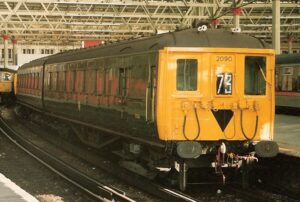
SR 2-BIL Electric multiple unit, Photo © Oxyman (cc-by-3.0).
The stopping trains on these lines consisted of 2-car BIL or HAL units or else 4-car LAV units. The latter were so designated because one of the coaches contained a lavatory which deposited its contents directly on to the track. As naughty boys in the 1950s, when returning from a trip to Horsham swimming baths, my friends and I would attempt to score a direct hit on the High Street level crossing as the train slowed to enter the old Crawley station. However, by 1960 we’d grown out of such childish games.
Even the express trains, passing through Three Bridges station at 60 mph were boring green multiple units, except for the twice daily ‘Brighton Belle’ which did at least have a brown and cream ‘Pullman’ livery.
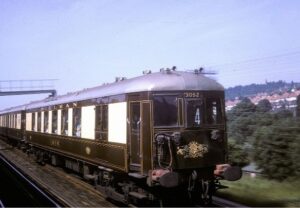
The ‘Brighton Belle’ 5-car unit 1964
Photo © Tony Hagon (cc-by-3.0).
The only locomotive hauled express train was the daily Newhaven-Dieppe Boat Train (whose timings varied according to the tides) which was then hauled by one of three Southern Railway electric locomotives of 1940s vintage.
There was, however, one line in the area that had not been electrified and was still operated by steam locomotives. This was the hourly shuttle service from Three Bridges to East Grinstead operated by small tank engines converted to push-pull working, so that the locomotive did not need to run around its train at each end of the journey. Thus, for return journeys the locomotive and fireman would be at the rear of the train with the driver sitting in a compartment in the front coach. As boys we often used this service to go swimming at East Grinstead during the summer holidays since Crawley had no swimming baths until 1964.

Class ‘H’ tank engine at Three Bridges station in Jan. 1962.
Photo John M. Cramp
http://disused-stations.org.uk/t/three_bridges/index.shtml
The service was hauled by steam locomotives until January 1964 when diesel-electric multiple units, nicknamed ‘Thumpers’ for reasons obvious to their passengers, took over. The service struggled on for three more year but in January 1967 the line through to Tunbridge Wells was closed as part of the cuts to the rail network recommended by Dr. Beeching. He happened to live in East Grinstead and when part of the track bed was later used for the A22 relief road in the town, a local wag suggested they named it ‘Beeching Cut.’
There were a lot more goods and freight services than there are today, which were still operated by steam locomotives. Many everyday products were collected and delivered by rail. As with most market towns and some larger villages, Crawley station had sidings and a goods depot which was visited once or twice a day by a ‘pickup-goods train.’ Deliveries of the merchandise were then made around the town by three-wheeled Scammel Scarab trucks. There was also a goods yard north of Three Bridges on the Gatwick Road industrial estate, where coal and other minerals were brought for re-distribution by road and rail.
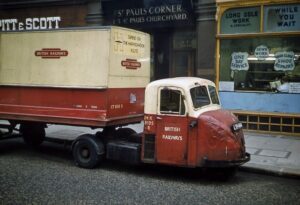
A BR ‘Scammel Scarab’ truck.
Photo © Infrogmation (cc-by-sa/2.0).
A larger freight yard to the south of Three Bridges station was only partially used. During the First World War, Three Bridges had been chosen by the Rail Operating Department as a nodal hub for the receipt of munitions and their onward transmission to Newhaven and later Littlehampton harbours for shipment to the Western front. This location was presumably chosen as the area (now part of Furnace Green) was sparsely populated. Thus, the existing sidings were rapidly expanded and new ones created so that supply trains could be received from elsewhere in England. In April 1918 one of these ammunition trains ran into the wreckage of a derailed goods train in Redhill tunnel. It was only through a miracle that there was no fire and the unsung heroism of railway workers which averted a major disaster for that town.
There were occasional steam ‘specials’ passing through the Crawley stations, especially on summer Bank Holidays when excursions from Birkenhead and Manchester to Brighton and Eastbourne were often run. These might be hauled by a locomotive from another region such as a ‘Black 5’ class. One day, in the spring of 1959 several local junior schools chartered a train from Crawley for a day trip to Southampton Docks. The train was headed by a huge slab-sided locomotive with the curious name ‘Appledore’. I later discovered that it was a member of the ‘West Country Class’ named after Devon villages.
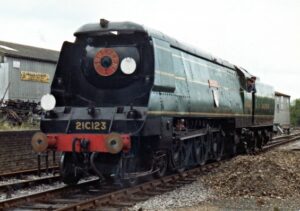
A ‘West Country’ class locomotive
Photo © Richard Hoare (cc-by-sa/2.0).
However, the focal point for serious loco spotting in Crawley was the former London Brighton and South Coast Railway (LBSCR) depot at Three Bridges, situated in the fork between the lines to Brighton and Crawley. It was a brick built three-lane shed, opened in 1911, replacing an earlier building dating from 1848 which was demolished during the enlargement of the station. The structure included a large water tank above a workshop, a separate coal stage, a hoist for lifting locomotives and a 60ft turntable.
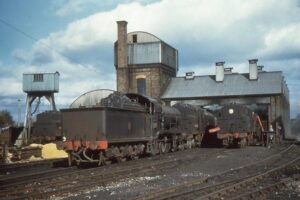
Three Bridges Motive Power Depot in May 1962.
Photo: copyright unknown https://thesussexmotivepowerdepots.yolasite.com/three-bridges-mt.php
The Depot was approached by a cinder path which ran from just outside the station, under the line to Crawley. It was a medium sized depot with an allocation of about thirty-five steam locomotives throughout the 1950s reducing to 29 between 1959 and 1962, but also servicing visiting locomotives from other depots. This number rapidly declined during 1963 until its eventual closure to servicing steam locomotives in January 1964. It then became a ‘Mixed Traction Depot’ where steam, diesel and electric locomotives were stabled overnight or else stored awaiting disposal but were no longer serviced. The depot closed altogether in April 1969, although the buildings were occasionally used for rolling stock repairs over the next few years before they were demolished in the mid-1970s. It is now the site of the Siemens Three Bridges Traincare Facility. As youngsters we never experienced any difficulty in gaining access to the shed, whereas we were sometimes prevented from accessing that at Redhill and were thrown out and threatened with the police at Guildford.
Three Bridges depot retained some medium-sized tank locomotives to run the East Grinstead shuttle services. For most of the time three fifty-year-old South Eastern and Chatham Railway (SECR) ‘H’ class locomotives were used which were popular with the local crews. An attempt by managers to replace them with even older London and South Western Railway ‘M7’ class 0-4-4 tanks about 1960, was not popular as they were more difficult to operate in push-pull mode. However, with the electrification of the main lines in Kent during 1961 more examples of the ‘H’ class became available and the last three survivors of the class saw out their days working from Three Bridges during 1963. The last survivor no. 31263 was in traffic until 4 January 1964, when it was withdrawn and stored at the shed until the following November, It was then hauled away to preservation, initially at Robertsbridge, although it eventually found its way to the Bluebell Railway.
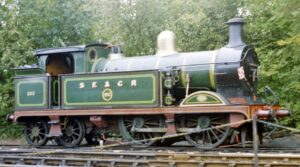
‘H’ class no.263, as preserved at the Bluebell Railway
Photo © Ben Brooksbank (cc-by-sa/2.0).
The freight locomotives allocated to the depot in the 1950s and early 1960s were principally of LBSCR designs. The ‘C2X’ class 0-6-0 locomotives had once provided the mainstay of freight motive power in the area. There were eight of them at the depot in 1958, all then fifty years old. They were withdrawn during 1960 and 1961 with the last survivor leaving in February 1962. A friend and I were once given an unofficial footplate ride on ‘C2X’ No. 32522 around the shed yard in the Spring of 1961 by a cleaner. These were replaced by newer Southern Railway ‘Q ‘class recently made redundant from elsewhere in the region.
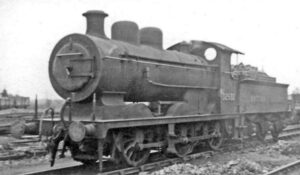
C2X Class 32532 at Three Bridges Depot in 1948.
Photo © Ben Brooksbank (cc-by-sa/2.0).
My favourite class were the larger mixed-traffic ‘K’ class, introduced just before the First World War. These had done prodigious work hauling both munitions and troop trains and had also later come into their own during the lead up to D-Day landings. They were robust locomotives, popular with the crews and capable of doing the work of much larger classes. Nine of the seventeen of them were allocated to Three Bridges and by 1961 they were the last pre-World War I class in the country still extant. Then, in December 1962, the entire class was withdrawn en-bloc. The decision to do so was due to a wish to keep up with the Southern Region’s withdrawal programme rather than any consideration of their usefulness or condition. This upset many local crews as most of them were in good working order and the replacement ‘N’ class, although newer, were thought to be inferior locomotives. The withdrawn ‘K’ class locos were stored at Hove Goods Yard for many months before they were cut up. No. 32345, was stabled at Three Bridges until September of 1963 in the hope that it might be purchased by the Bluebell Railway, but they needed rather to concentrate on buying the freehold of their track.
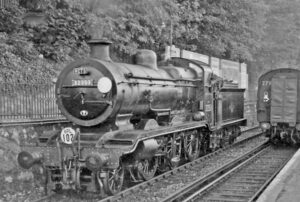
K Class 2-6-0 No. 32342 at Brighton.
Photo © Ben Brooksbank (cc-by-sa/2.0).
The ‘K’ class duties were partly taken over by the ‘N’ class and the powerful ‘Q1’ class of 0-6-0, built by the Southern Railway in the early years of the Second World War. Four of these unusual looking locomotives were transferred to the depot in September 1962, followed by four more in September 1963 when the depot lost its locomotive allocation.
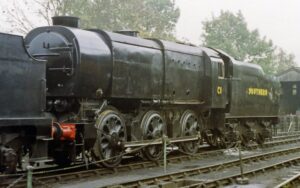
Q1 Class 0-6-0, C1 at the Bluebell Railway 1992
Photo © Ben Brooksbank (cc-by-sa/2.0).
Three sixty-five-year-old veteran tank loco-motives were allocated to the depot in the early 1960s. These were members of the ‘E4’ class, originally built for London suburban passenger trains but were still being used for shunting and short distance freight trains in the area until 1961. One of them even lasted until June 1962. Another survivor, no. 32473, formerly working at Nine Elms depot in London, was sold to the Bluebell Railway on 16th October 1962, where it was restored to its original livery and given the name ‘Birch Grove’.
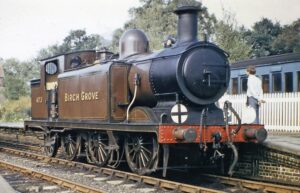
E4 ‘’Birch Grove’ at Sheffield Park, Bluebell Railway Photo © Ben Brooksbank (cc-by-sa/2.0).
The two largest tender locomotives at the Three Bridges depot in the early 1960s were of the British Railways standard class ‘4’ mixed-traffic locomotives. The first of these, no. 75075 was transferred to the depot in May 1959 and the second, no. 75070 followed soon afterwards. Both were still relatively new having been built at Swindon Works in 1955. One or other of these was often to be found at the depot but I never did discover what duties they were used for.

A British Railways Standard Class ‘4’ 4-6-0.
Photo © David P Howard (cc-by-sa/2.0)
The depot also retained four large modern class ‘4’ tank locomotives which were used on the morning and evening passenger services over the East Grinstead and Tunbridge Wells lines and also on steam services over the unelectrified lines between London, Brighton and Eastbourne via Oxted or Tunbridge Wells. These locomotives had been designed and more than one hundred built at Brighton Railway Works which was a significant builder of steam locomotives throughout the 1940s and 1950s until its closure in 1958.
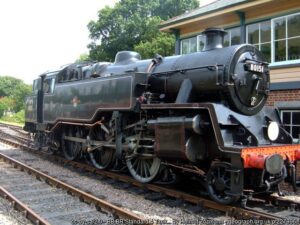
BR Standard 4 Tank Engine No. 80151
© Helmut Zozmann (cc-by-sa/2.0).
The late fifties and early sixties therefore saw the rapid replacement of steam locomotives with their diesel equivalents. This began with the appearance of BR/English Electric (EE) diesel electric shunters of the standard 0-6-0 type (later BR ‘class 08’) which started to appear in the Three Bridges goods yards from the mid-1950s, although they were never allocated to, or serviced at, the depot, which concentrated on servicing steam locomotives. They were sent down from Norwood Junction depots, which housed and serviced numbers of them, to work for a week at a time before returning to their homes. The only regular mainline diesel sightings in the area were the BR/Birmingham Railway Carriage and Wagon Company (BRCW) ‘type 3’ Bo-Bo class, known as ‘Cromptons’ (later British Rail ‘class 33’). These were introduced in 1960 and were gradually spreading throughout the Southern Region as new examples were being delivered. By the summer of 1963 they were beginning to be stabled overnight at Three Bridges Depot although they were all allocated to Hither Green Diesel Depot in east London.
We were also lucky in Crawley living only twelve miles from the Bluebell railway at Horstead Keynes, which could easily be visited by bicycle. In the spring of 1961, when I first visited, they only had two tiny
0-6-0 tank engines operating. These were a Wainwright ‘P’ class of the SECR named ‘Bluebell’ and an ‘A1X’ class of the LBSCR, named ‘Stepney’. The ‘A1X’ class built between 1872 and 1880, were nicknamed ‘Terriers’ and were the oldest steam locomotives still at work.
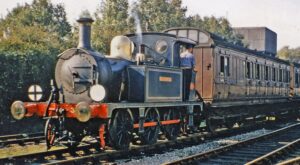
‘P’ class tank ‘Bluebell’ on Bluebell Railway at Sheffield Park.
Photo © Ben Brooksbank (cc-by-sa/2.0).
During the next three years the railway would acquire further interesting locomotive types from British Railways, including another A1X named Fenchurch. Other interesting acquisitions included the Adams radial 4-4-2 tank No. 488 from the London and South Western Railway (LSWR) or the former North London Railway (NLR) ‘goods’ locomotive No. 58850. Ultimately the Bluebell Railway would save about fifty steam locomotives and become the largest collection outside the National Railway Museum at York as well as relaying a substantial section of the original track as far as East Grinstead.
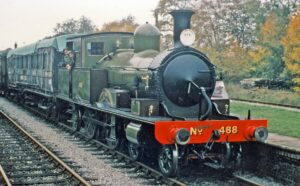
Adams radial tank 488 on Bluebell Railway
Photo © Ben Brooksbank (cc-by-sa/2.0).
As young teenagers our trainspotting activities were by no means restricted to Crawley, My friends and I made several visits to the Motive Power Depots at Brighton, Horsham (officially closed but still used for storing locomotives), and Redhill (usually accessible on Sundays when the offices were not manned). We travelled on non-electrified routes where steam still operated, such as Horsham to Brighton, Three Bridges to Tunbridge Wells, and Redhill to Guildford and Tonbridge, all funded by our earnings from our paper rounds. There were also opportunities for day trips to London the great centre for loco enthusiasts where there were a dozen or more large depots. My brother and I likewise used family holidays as opportunities to go trainspotting further afield.
By March 1964, when I was sixteen, trainspotting had begun to be depressing as so many locomotives that we loved were being scrapped. Also, I acquired a secondhand motor scooter and so my interests moved on. However, I have never regretted the five years that I spent as a keen train spotter and in the process I learned a great deal about economic history, political geography, mechanical engineering and many other subjects without being aware that I was doing so.
(David Stoker, May 2020)



